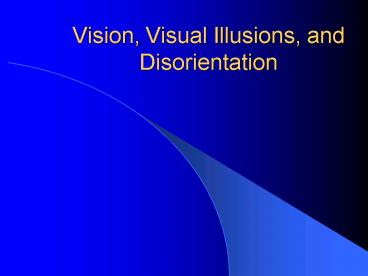Vision, Visual Illusions, and Disorientation - PowerPoint PPT Presentation
1 / 19
Title:
Vision, Visual Illusions, and Disorientation
Description:
Vision, Visual Illusions, and Disorientation. Characteristics of Light ... Examples of visual illusions. Geometric optical illusions /page 118 ... – PowerPoint PPT presentation
Number of Views:663
Avg rating:3.0/5.0
Title: Vision, Visual Illusions, and Disorientation
1
Vision, Visual Illusions, and Disorientation
2
Characteristics of Light
- Light-is radiant energy which is capable of
exiting the retna of the eye and is visible
radiant energy - Reflected light-off a surface gives off
brightness - Absorbed light-on a surface gives off
illumination - Contrast-the relationship of a target to its
background brightness - Refraction-when light passes through a medium of
different density it is bent - Color-variations in wavelengths give rise to the
perception of color (color blindness-unable to
see red and green)
3
Physiology
- Pupil-aperture that controls the amount of light
entering the eye - Iris-muscles that adjust the pupil
- Cornea-transparent lense on front of the eye
which focuses light to the back of the eye - Retina-back of the eye which the cornea focuses
the light to - Fovea-center of retina has light receptors
(rods on the outside pick up dim
light/cones in the center pick up brighter light)
4
Adaptation
- When the amount of light varies an adaptation
takes place from the use of cones to rods (day to
night) and rods to cones (night to day) - The adaptation process varies with age
5
Variables of visual acuity
- Visual acuity is what a person can read off of a
chart at 20 feet - Age decrease visual acuity (at age 40 it begins
to decrease until at age 65 it is half of what it
is) - Brightness affects visual acuity
- Contrast affects visual acuity
- Glare affects visual acuity
6
3 safety of flight visual ranges
- Overhead panel-13-16 inches
- Instrument panel-30-35 inches
- Infinity-outside world
- Deterioration of these ranges can lead to a false
reading or missing traffic and needs to be
corrected
7
Visual Perception
- Vision-eye-brain-experience and memory-pilot
action aircraft response-visual feedback - However the inner ear also sends signals to the
brain that affects visual perception - Motion-inner ear-brain-experience and
memory-pilot action-aircraft response-motion
feedback
8
The Blind Spot
- Each eye has a blind spot that is filled by the
other eye when using binocular vision - If vision of an object by one eye is obstructed
by a windshield then the visual target could be
in the blind spot - See example page 115, Fig 5.7
9
Cues that help or hinder depth perception
- Binocular vision
- Perspective
- Apparent movement of the object
- Superposition
- Relative size
- Height of an object in the plane
- Texture gradient
10
Hypoxia and smoking
- Hypoxia-condition resulting from an oxygen
deficiency (8000 feet plus) - Differs with different individuals
- Reduces night vision and side effects
- Smoking introduces carbon monoxide to the blood
stream and reduces the flow of oxygen to the
brain - A heavy smoker can get hypoxic at 5000 feet
11
Positioning and sitting
- Sitting in the proper eye position is important
in preventing accidents on final approach caused
by eliminating view of the landing zone on final
from poor eye positioning caused by improper
seating
12
Examples of visual illusions
- Geometric optical illusions /page 118
- Depth and distance illusions/page119
13
Illusions on the ground
- Illusion of moving when the gate is moving
- Blowing snow or rain can give the illusion that
the aircraft is moving - Pilots eye can misjudge the speed and can cause
excessive speeds - Rain and precipitation and night can affect
speed - Mist and fog can influence judgement
14
Takeoff Illusions
- Accelerations could lead to illusions of turning
- Acceleration- gives a pitching up sensation and
can cause a tendency to push down - Deceleration- can cause a pitch down sensation
and a tendency to pull up - After takeoff-false horizon perception can occur
when stars appear as lights on a runway
15
Cruise Illusions
- Prolonged turning-can create an illusion of a
holding pattern - Auto kinesis-is the apparent moving of a
stationary light at night - Evaluation of an approaching object(aircraft,
mountains etc) and the proper assessment of
collision risk - The blind spot
16
Approach and landing illusions
- The most critical phase of flight and the most
fatigued potential phase of the flight and can
include adverse weather..error can be
catastrophic - Sloping terrain-can give the illusion of being to
low or to high depending on which way the runway
slopes on landing - Runway width and lighting intensity-the wider and
the brighter, the more closer the aircraft feels
17
Black Hole effect on landing
- Occurs when approaching airports at night over an
unlit area - Causes an illusion of height/giving way for a
height higher than reality - Pago Pago 1974- Boeing 707 crashes short of
runway killing 96 people on board
18
Measures to prevent illusions
- Step1-all must agree that visual illusions are
normal phenomenon and educate - Step2-Get to understand the nature and situations
where they will be encountered - Step3-Brief the possibility of such an illusion
occurring - Step4-publish it where necessary for certain
geographical areas - Step5-Correct manufacturers design
19
(No Transcript)































